| |
Hong Kong
Hong Kong held 3,000 Chinese scattered in small fishing villages until the mid 19th century. The city itself is a small island in the mouth of the Pearl River, 76 miles southeast of Canton. Its waterfall at Aberdeen had initially attracted British attention because it provided a convenient fresh water supply, but Hong Kong’s superb harbor was its main asset. The British traveler Robert Fortune captured this promise early on:
Hong-kong bay is one of the finest which I have ever seen: it is eight or ten miles in length, and irregular in breadth...having excellent anchorage all over it, and perfectly free from hidden dangers. It is completely sheltered by the mountains of Hong-kong on the south, and by those of the mainland of China on the opposite shore; land-locked, in fact, on all sides; so that the shipping can ride out the heaviest gales with perfect safety. |
|
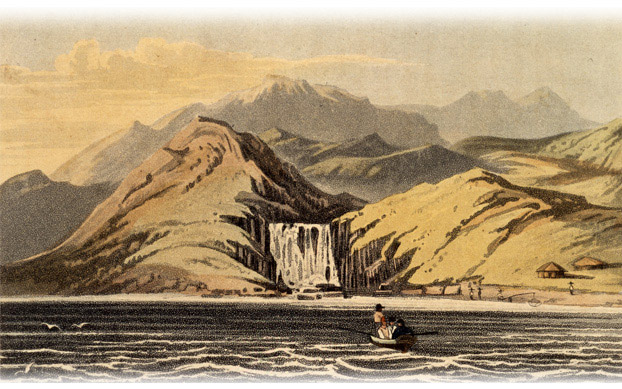 |
| |
The waterfall at Aberdeen attracted British attention because it provided a convenient fresh water supply.
“Waterfall at Aberdeen,” 1817
by William Harvell, text on print: “The Waterfall, at Hong Cong.”
Hong Kong Museum of Art [cwHK_1817_AH64362]
|
|
| |
After their victory in the first Opium War, the British acquired the island under the 1842 Treaty of Nanking, and named the island’s capital city Victoria. Soon the Chinese population more than doubled, to fifteen- to twenty-thousand people, and Hong Kong along with Shanghai surpassed Canton as the main centers of China’s foreign trade. Piracy and disease afflicted the colony in the early years, but many Chinese fled to Hong Kong to escape the rebellions and disorder that struck the Chinese interior in the 1850s. By 1859 Hong Kong had over 85,000 residents, and had become the center of a wide-ranging overseas Chinese trading network, dominated by the prosperous Hong Kong business elite under British colonial protection. The founding of the Hong Kong and Shanghai Bank in 1864, based on Chinese capital, showed that Hong Kong had become the leading financial center on the Chinese coast for international trade.
|
|
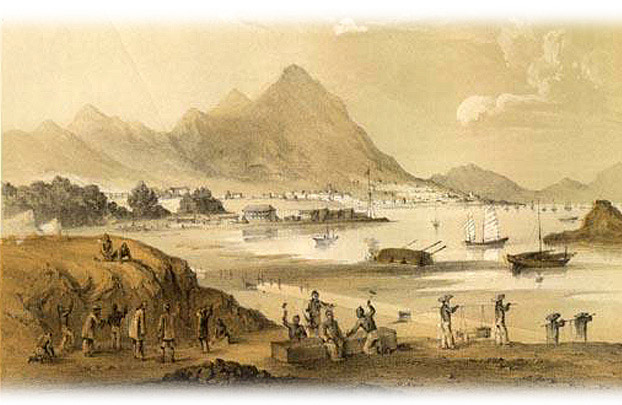 |
| |
Perry himself observed that there was "every sign of commercial prosperity, although the place is not very attractive to visitors.”
“View of Hong Kong From East Market, April 7, 1853”
by William Heine”
Commodore Matthew Perry's Japan Expedition [cwHK_1853_Heine_bx]
|
|
| |
Victoria peak dominates most pictures of the city in the early years. The small but growing settlement gradually climbed up the peak as the city grew. The waves of new immigrants clustered around the port while Western-style residences higher up the peak became the most prestigious in the colony.
|
|
| |
“View of Victoria Town, Island of Hong Kong, 1850”
by B. Clayton
Hong Kong Museum of Art [cwHK_1850_AH64251]
| |
| |
Unlike Canton, the British faced no restrictions from Chinese officials on where they could live or walk, and men and women could associate freely. The British tried to recreate a small version of English life at home on the distant shores of Asia. Although they were still a minority in the midst of a growing Chinese population, the colonial government protected Westerners from the local population and gave them privileges. Chinese merchants and workers, who could do business without facing the hong merchant monopoly or supervision from the hoppo, found that they could prosper in Hong Kong if they cooperated with the British. They helped to defend the colony against attack in the second Opium War and used their access to the British global empire to gain wealth and prestige. In the face of rebellions in China and threats from the Qing imperial government, the British carefully kept order in Hong Kong while encouraging trade by both Chinese and Western merchants.
|
|
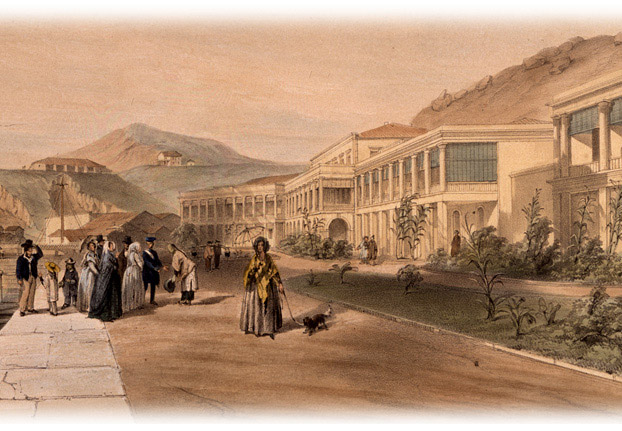 |
| |
In this idealized view of early Hong Kong, Western men and women gather in the gardens while a Chinese man bows respectfully to them. Hong Kong was a single woman’s paradise, according to the naval officer Lt. Edward Cree, with “forty ladies and four times as many men.” Even though thousands of Chinese had come to the city, artists chose to focus mainly on the foreign occupants.
“View of Spring Gardens, Hong Kong, 20th August, 1846”
painting by Murdoch Bruce, lithograph by A. Maclure
Hong Kong Museum of Art [cwHK_1846_AH643890]
| |
| |
Flagstaff House, built in 1846 for the first military governor of the colony, still survives as the oldest residential colonial structure in Hong Kong. It continued to be the British military headquarters until 1932, and is currently the Museum of Tea Ware.
“Flagstaff House, Hong Kong,” 1846
drawn by Murdoch Bruce, lithograph by A. Maclure
Hong Kong Museum of Art [cwHK_1846_AH643898]
| |
| |
The urban architecture of Hong Kong reflected the British determination to remold Chinese territory on the European model. Causeway Bay, for example, became the celebrated site of both a mint (with a formal garden) and the powerful Scottish trading firm of Jardine and Matheson. William Jardine and James Matheson founded their company in 1832 in Canton and they grew rapidly by exporting tea and silk to England and smuggling opium from India to China. As soon as Britain acquired Hong Kong, they purchased land in the Causeway area. In contrast to many initially skeptical merchants, Jardine and Matheson believed that Hong Kong had a prosperous future. Later they expanded to the other major treaty-port cities on the Chinese coast, but they kept their headquarters in Hong Kong and played a dominant role in the political and economic development of the city. Jardine Matheson is still the largest private employer in Hong Kong and one of the largest shipping companies in the world.
|
|
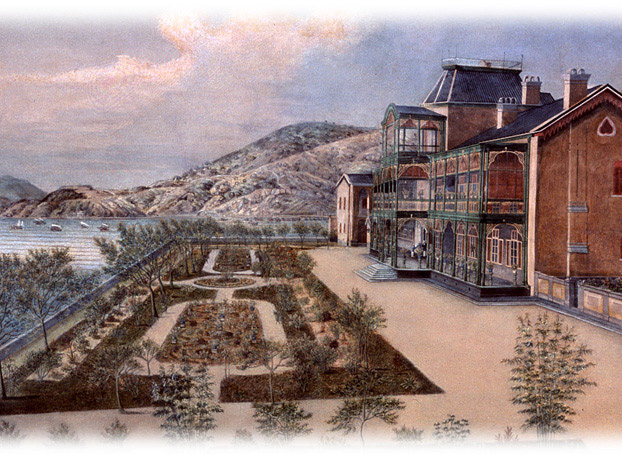 |
| |
Causeway Bay became the site of British financial institutions like the Mint, depicted here in the 1860s.
“The Mint and its Garden, Hong Kong,” 1860's, unknown artist
Hong Kong Museum of Art [cwHK_1860s_AH8813]
|
|
| |
American businessmen, however, soon entered the trade to compete with the British. The Massachusetts traders Augustine Heard, Joseph Coolidge, and John Murray Forbes broke away from the firm of Russell and Company to create their own business in 1840, and in 1856 moved their headquarters from Canton to Hong Kong. They built their residence on a hill overlooking the harbor. The Heards introduced steamboats to China, and after the legalization of the opium trade made great profits from shipping opium along China’s inland rivers. The Heard company collapsed in bankruptcy in 1875.
|
|
| |
In 1856 the head office of major American trading firm Augustine Heard and Company, with operations in Shanghai and Fuzhou, was moved to Hong Kong from Canton.
“Residence of Augustine Heard and Company, Hong Kong”
ca. 1860, unknown artist
Peabody Essex Museum
[cwHK_1860c_M17297]
|
|
| |
As in Canton, British and Americans commissioned Chinese painters to depict their new outposts in the Pacific. Western artists likewise focused on the new Western buildings, ships clustered in the harbor, and the dramatic mountain scenery. Unlike Canton, however, Hong Kong was a colonial possession completely under the domination of a foreign power, and many foreigners viewed the native Chinese population with fear and contempt. The visiting missionary George Smith, for example, wrote this in 1846:The lowest dregs of native society flock to the British settlement, in the hope of gain or plunder. Although a few of the better classes of shopkeepers are beginning to settle in the colony, the great majority of the new-comers are of the lowest condition and character. The principal part of the Chinese population in the town consists of servants, coolies, stone-cutters, and masons engaged in temporary works. About one third of the population live in boats on the water. The colony has been for some time also the resort of pirates and thieves, so protected by secret compact as to defy the ordinary regulations of police for detection or prevention. In short, there are but faint prospects at present of any other than either a migratory or a predatory race being attracted to Hong Kong, who, when their hopes of gain or pilfering vanish, without hesitation or difficulty remove elsewhere.
His attitude reflected the increasingly negative views of the Chinese that grew among missionaries and merchants after the Opium War.
|
|
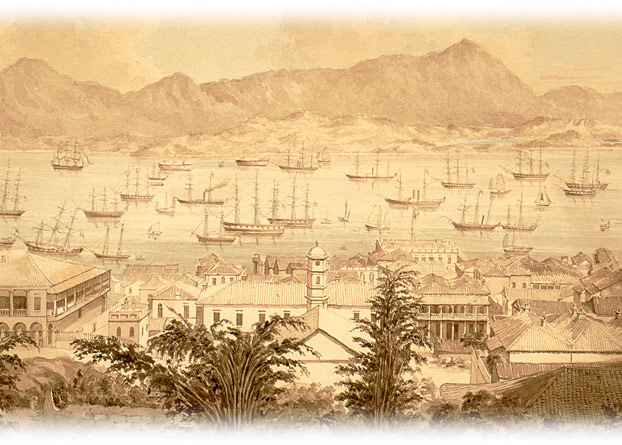 |
| |
In this “View of Hong Kong Harbor,” done by a Western artist some time between 1860 and 1870, Western architecture and foreign ships dominate the scene and there is no evidence of a Chinese presence.
“View of Hong Kong Harbor,” 1860–1870
Watercolor by Marciano Antonio Baptista
Peabody Essex Museum [cwHK_1860-70_M10874]
|
|
| |
In Canton, the foreigners lived in a well-established urban center whose population was governed by a systematic bureaucracy. Hong Kong was more like a frontier boomtown, where both foreigners and migrant Chinese went to escape the constraints of life at home or to get rich in a new place. Much of the population was unruly, but the British created an environment of security that could guarantee profits to most people. Refuting early skepticism about its future, during the late 19th century Hong Kong grew to become the primary port of trade with China, rivaled only by Shanghai. The British control of the island, its status as a free port, and its convenient coastal location made it the ideal place to gain access to the large Chinese market. Hong Kong was a freer place than Canton, but a much more colonial one.
|
|
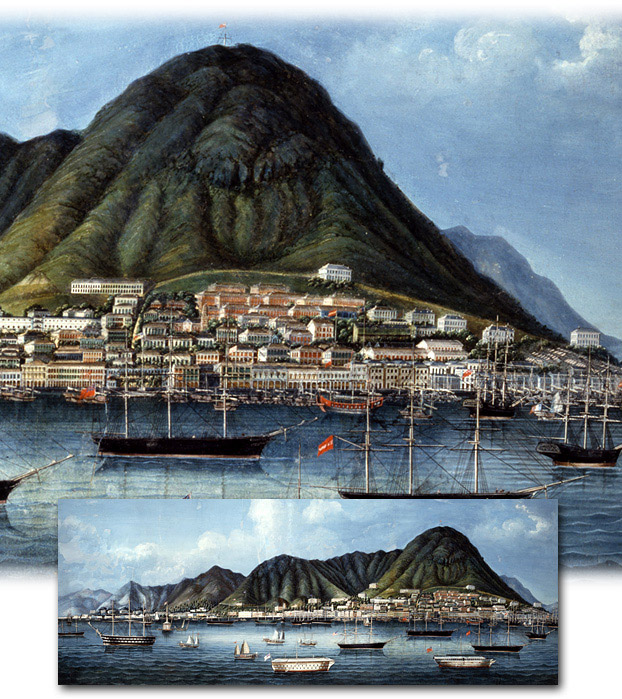 |
| |
Here again, Western buildings and vessels dominate the scene, with little sense of a human presence and no indication that this was part of China. This was typical of much of the colonial artwork centering on Hong Kong.
“City of Victoria, Hong Kong,” 1860–1865
Gouache on paper, unknown Chinese artist
Peabody Essex Museum [cwHK_1860-65_E81235]
|
|

Coda: Macau, Canton, & Hong Kong

|
| |
This fan combines views of Hong Kong (left), Macau (center), and Canton (right), 1845–65.
Peabody Essex Museum [cwOF_1845-65_E81311]
|
|
| |
The three Pearl River delta cities represented three distinct phases of Western commercial contact with China, and each city developed a special style. All three reflected the shift from strict Chinese control over foreign trade from the 16th through 18th centuries to the free trade era dominated by British colonialism in the mid 19th century. Portuguese Macau, the oldest Western settlement, retained a modest, charming, relaxed atmosphere dominated by its stunning beach, the fishing trade, the forts and churches. Canton, already a giant city before the Westerners arrived, placed the new foreigners in a segregated quarter but actively mingled native Chinese and foreign cultures in the interest of profit. Hong Kong, the most Western dominated, became a prize British colonial possession, where Chinese flocked to take advantage of the opportunities offered by contact with a wider world.
Architecture and street life in the three cities reflected their particular origins and populations. In Macau, the Portuguese churches and forts provided the backdrop for scenes of the many different religions and cultures of the local population. In Canton, Westerners in the factories peered out at the population of a giant empire, tantalizingly close, but mainly inaccessible. In Hong Kong, the colonial settlers and officials made themselves into a distinct class tightly closed off from the Chinese around them, and often ignored or feared the local population.
All three cities attracted visitors and temporary residents from around the world, while simultaneously serving as funnels for Chinese products entering the global market. For most Westerners, they became windows on a far-away and alien world—albeit windows that were always narrow and usually all but closed to any real appreciation or understanding of life in the interior and among the Chinese people as a whole. Foreigners by and large celebrated their own lives in sequestered enclaves on the China coast. They revealed their fine taste by collecting elegant Chinese artworks, all the while remaining largely silent about the fact that the funds that supported their exotic connoisseurship often rested on illicit trade in opium. Even while extolling the superior morality and civilization of the West and berating the Chinese for their shortcomings in “moral, honorable” conduct, they waged not one but two wars to force the Chinese to legalize opium imports, open additional ports to receive them, and agree to a low fixed tariff on all items in this great exercise in “free trade.”
The Opium Wars signaled the end of the old Canton trade system under which the great Qing dynasty held the upper hand and dictated who and how and under what restrictions trade could be carried out. China was indeed the “central kingdom” during this long span of time—powerful, self-sufficient, capable of warding off foreign threats and dictating the terms of its relations with other nations and peoples. Defeat in the Opium Wars, and the ensuing collapse of the old Canton-system regimen of controlled trade, signaled the emergence of the European and American powers as the new imperial arbiters of wealth and power—and the consequences for China were dire. England’s colonialization of Hong Kong was, in its way, a perfect symbol of this new impotence—and the modern history of China for a century and a half thereafter reflected this catastrophe. Once the commanding great civilization of Asia, China abruptly became an object to be acted upon—besieged for decades to come by both external threats and internal upheaval.
When Chinese in the 20th and even early 21st century spoke of their country’s “humiliation,” it was generally understood that this is when the great decline began.
|
|
| |

|
|
|

